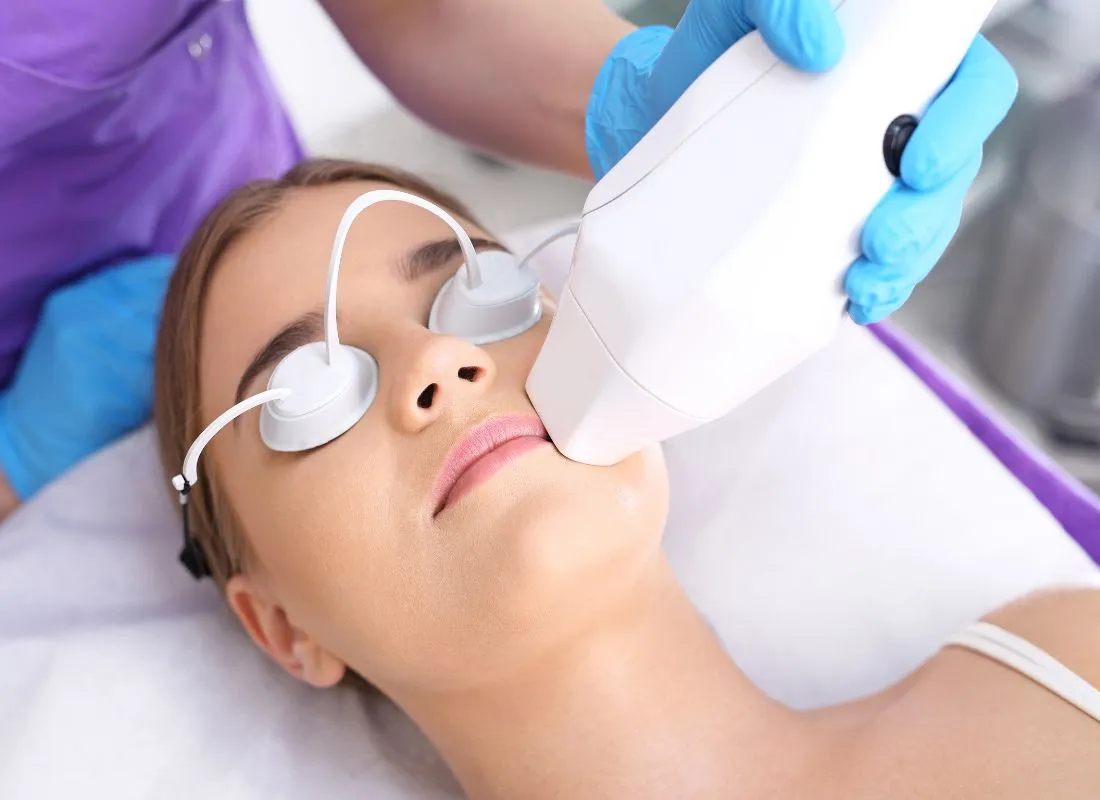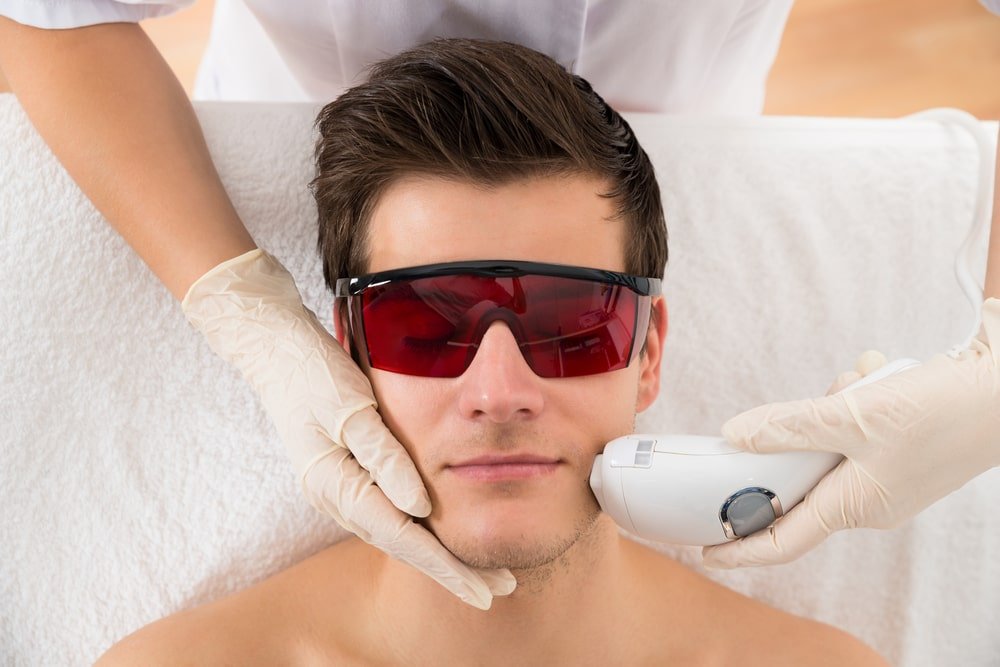Laser Hair Removal :
Are you sick of having to repeatedly shave, pluck, or wax in order to get rid of undesirable hair? In that case, laser hair removal may be the answer you’ve been looking for. This innovative method effectively removes hair from various regions of the body by using lasers, which are concentrated beams of light.One of the most well-liked cosmetic procedures in the UK is laser hair removal. It works by shining intensely focused light into the hair follicles. The pigments in these follicles absorb the strong light, causing the targeted hair to fall out. This ground-breaking method provides a durable answer to the persistent issue of unwanted hair.
What is Laser Hair Removal?

Laser hair removal is a medical procedure that removes unwanted hair by harnessing the power of concentrated light (laser). A laser is used to perform this operation, and the light it emits is absorbed by the melanin pigment in the hair. The little, tube-shaped sacs within the skin that are in charge of hair development, known as hair follicles, are the target of this heat that is produced from the absorbed light energy. Future hair development is inhibited or delayed by this injury.
Syringes are typically used to measure lip filler procedures, and each syringe has a specific amount of filler. As a point of reference, one syringe of lip filler normally holds between 0.5 ML Lip Filler and 1.0 milliliters (ml) of substance. It’s crucial to remember that while some people might only need a partial syringe, others might need more.
The aesthetic nurse at SVR Aesthetics or any respectable clinic will evaluate your lips during your appointment, talk to you about your goals, and suggest the right amount of filler to get the results you want. It’s essential to be open with the practitioner about your hopes and worries in order for the two of you to jointly develop the ideal strategy for your lip augmentation.
Purpose Of Laser Hair Removal:
Laser hair removal’s main goal is to get rid of unwanted hair. Legs, armpits, the upper lip, the chin, and the bikini line are among the common treatment regions. It is adaptable and can target hair almost anywhere, with the exception of the eyelids and the area around them. Additionally, laser therapy should not be performed on tattooed areas.
How to prepare for Laser Hair Removal?
For people who want to say goodbye to unwanted hair, laser hair removal is a wonderful option. However, a successful treatment approach depends on careful planning. An instruction manual for getting ready for laser hair removal is provided below:
Choose a Qualified Professional, first
Choose a board-certified physician with experience in dermatology or cosmetic surgery to start your journey. Make sure the expert has knowledge of laser hair removal for your particular skin type. Make sure a doctor supervises and is on hand throughout the treatments if a physician assistant or registered nurse will be performing the procedure. When considering spas, salons, or other locations that permit non-medical staff to perform laser hair removal, proceed with caution.
Assessment by the physician
Make an appointment for a consultation with the selected physician to discuss whether laser hair removal is a good fit for your requirements. The doctor’s instructions for this consultation are:
Go over your medical background, including any drugs, skin conditions, scarring history, and hair removal techniques used in the past.
Talk about the potential drawbacks, advantages, and reasonable expectations related to laser hair removal.
For initial evaluations and to document your improvement throughout the course of treatment, take pictures.

Treatment Plan and Costs
Work with the doctor to develop a personalized treatment plan and comprehend the costs involved during the consultation. You should be aware that laser hair removal is sometimes regarded as an out-of-pocket expense.
Sun Protection
It’s essential to prevent sun exposure both before and after the surgery. Follow your doctor’s advice to avoid the sun, and use a broad-spectrum SPF30 sunscreen whenever you’re outside.
Skin Lightening:
Steer clear of sunless skin care products that darken skin. A skin whitening cream may be recommended by your doctor if you recently tanned or have darker skin.
Avoid electrolysis, waxing, and other hair removal procedures
for as least four weeks prior to your laser treatment. These techniques may damage the hair follicle, which would reduce the effectiveness of the laser therapy.
Medications
Speak with your doctor about any medications you should avoid taking before to the surgery, such as aspirin or anti-inflammatory drugs.
Pre-Treatment Shaving
It is advised to trim and shave the treatment area the day before your laser treatment. By removing the hair above the skin’s surface, this procedure protects the skin’s surface from burns while leaving the hair shaft intact beneath the skin.
By making these thorough preparations, you can approach your laser hair removal procedure with confidence and have a smoother and more successful procedure.
Who Is a Candidate for Laser Hair Removal?

Anyone looking to decrease unsightly body hair and enhance their looks can benefit from laser hair removal. It is frequently used for cosmetic purposes to do away with the necessity for routine shaving. Additionally, people with excessive hair growth brought on by diseases like hirsutism or hypertrichosis may benefit from laser hair removal. These problems may be brought on by things like prescription drugs, hormonal imbalances, genetic disorders, or ailments like PCOS or tumors that produce hormones. While those with dark hair and light complexion benefit from laser hair removal the most, those with dark skin or light, blonde, gray, or red hair may experience drawbacks.
Laser hair removal vs Electrolysis :
Making the Best Decision Between Electrolysis and Laser Hair Removal. Two popular methods of hair removal frequently stand out: electrolysis and laser hair removal. Let’s examine the variations so you can make a wise choice:
Laser Hair Removal Method :
Laser hair removal targets hair follicles with focused light. The pigment in the hair absorbs the laser’s energy, inhibiting further growth.
Suitability: Due to the contrast in pigmentation, laser hair removal works best on people who have light skin and dark hair.
Treatment Time: Because sessions are brief, it is appropriate for treating larger areas like the back and legs.
Effectiveness: While hair growth is greatly reduced, permanent hair removal may not be achieved, necessitating many maintenance sessions.
Electrolysis Method :
To stop hair from growing, electrolysis involves putting a probe into each hair follicle and applying an electric current to stop it.
Suitability: It is adaptable for a wider variety of people because it works on all skin and hair tones.
Treatment Time: Electrolysis is a precise but laborious procedure that works best on little areas, such the upper lip or eyebrows.
Effectivness: Electrolysis is said to be more effective than laser hair removal and can produce results that endure for years.
Consider your skin and hair color, the treatment area’s size, and your desired level of permanence when choosing between the two. Your decision may be influenced by your own needs and tastes, but both solutions might be worthwhile.
Is Laser Hair Removal Painful?
One of the main questions that frequently comes up when considering laser hair removal is how uncomfortable it will be. For individuals thinking about undergoing this common cosmetic procedure, knowing what to expect in terms of pain is essential.
- It’s crucial to understand that while discomfort from laser hair removal might occasionally occur, it is usually minimal and tolerable. Individual differences exist in the sensations felt during the operation.
- Many people who have had laser hair removal claim that it feels like warm pinpricks on their skin. It’s crucial to keep in mind that everyone has a different threshold for pain, so when one person
- Laser hair removal is frequently seen as less painful than conventional hair removal techniques like waxing or threading. Because laser treatment is a more comfortable choice, many people choose it.
- Some people may have minor edema and redness in the treated area after the operation. These side effects are typical and usually go away very soon.
In conclusion, even while laser hair removal may cause some pain or discomfort, most people find it manageable, especially when compared to other hair removal methods. In the end, discomfort levels vary from person to person. Before undergoing laser hair removal, it is recommended to speak with a skilled practitioner to go through your individual concerns and expectations. By doing this, you can make sure that you are ready.
Laser Hair Removal at Home ?
Although there are at-home laser hair removal equipment on the market, getting treatment from a professional is typically seen as a safer and more successful option. This advice is supported by a number of important factors, including:
Lack of Long-Term Research
The effectiveness and safety of at-home laser hair removal equipment have not been thoroughly studied over an extended period of time. As a result, compared to expert therapies, the potential hazards and results connected with these devices are still less evident.
Cosmetics vs. medical technology
Tools for at-home laser hair removal are classified as cosmetic rather than medical equipment. They are therefore subject to different legal requirements and quality assurance procedures than equipment of a professional caliber. The latter is subject to stricter criteria to make sure
Professional knowledge
You gain from the knowledge and experience of the qualified professional doing your laser hair removal. They can modify the treatment to meet your unique needs, making the required adjustments to the parameters for the best outcomes with the fewest possible adverse effects.
What is cost of Laser Hair Removal?
Although laser hair removal is a well-liked cosmetic operation, the price can vary greatly depending on a number of criteria. Here is a closer look at the factors that can affect how much laser hair removal costs:
Treatment Area and Length of Time: The size of the treatment area and the length of time required for each session are two major factors that affect price. Generally speaking, larger areas—like the legs or back—cost more than tiny ones—like the upper lip or underarms.
The quantity of sessions: Multiple treatment sessions are frequently necessary to get the best outcomes. The overall cost will rise if more sessions are required to remove the hair effectively. Some people could require four to six sessions spaced out over several weeks.
Credentials of the Practitioner: The price may vary depending on whether a doctor or a certified technician performs the treatment. Medical practitioners may demand higher fees in exchange for their knowledge and guidance.
Geographical Location: By geography and location, laser hair removal costs can also differ. In urban areas and places with a greater cost of living, procedures are frequently more expensive.
It’s advisable to speak with a consultant to receive a precise estimate of the price for your unique laser hair removal needs.
Risks and Recovery: What to Expect
Swelling Like Sunburn
For 1-2 days after treatment, the affected area could feel and look like a mild sunburn. Moisturizers and cool compresses can be applied to relieve pain. Unless there are blisters, makeup can typically be worn the day after treatment.
Sun Protection
After laser hair removal, you should avoid using tanning beds, sunlamps, indoor tanning devices, and direct sunlight. For the following, wearing sunscreen is advised
Potential Negative Effects Although it’s rare, some people could encounter negative consequences like swelling, redness, or scars. Rarely occur permanent scars or severe skin color changes.
Rare side effects
Blisters, which are more prevalent in those with darker skin tones, blisters, and the potential for treated hair to turn gray or to grow more hair in the treated places are examples of rare side effects.
Selection of a Qualified Provider
It is essential to get laser hair removal done by a qualified and respected technician or medical specialist in order to reduce dangers and guarantee the finest results. Before having the treatment, it is crucial to verify the practitioner’s credentials and training. Despite the availability of at-home laser hair removal devices, it is generally advised to seek expert treatment like booking an appointment at SVR Aesthetics in Milton Keynes UK.
FAQ
Frequently asked questions.
How long-lasting is laser hair removal?
With proper upkeep, results can endure from a few months to several years.
Is Brazilian Laser Worth It?
Brazilian laser gives long-lasting effects, particularly for pale skin and dark hair.
Can All Hair Be Removed by Laser?
Laser decreases or eliminates hair, however the extent of elimination varies depending on the skin and hair types.
What happens during Laser Hair Removal?
The area is cleaned prior to treatment, and a numbing gel may be used. The technique requires the wearing of protective eyewear. Hair is vaporized using a laser, which frequently feels like warm pinpricks.
What should I do Following Laser Hair Removal?
Stay away from tanning beds and protect your skin from the sun. Follow the aftercare advice provided by your dermatologist. Expect minor sunburn-like redness and swelling that will be relieved by a cool compress.
Does Recovery Time Follow Laser Hair Removal?
There is typically no downtime, therefore no. After the operation, you can get back to your regular activities.
When Can I Expect Results?
After the first treatment, there is a 10% to 25% loss of hair, though immediate outcomes can vary. For total eradication, 2 to 6 sessions are required. Usually, hair grows back finer and lighter.
How Long Are Results Durable?
Results can persist from months to years, however some may require follow-up sessions.
What Potential Side Effects Are There?
Typical adverse effects, such as pain, edema, and redness, are transient. Blistering, infections, and alterations in skin tone are rare adverse effects.
When Is It Safe to Try a Different Treatment?
As recommended by their dermatologist, patients can often schedule sessions every 4 to 6 weeks.





I don’t think the title of your article matches the content lol. Just kidding, mainly because I had some doubts after reading the article.
Thank you for your sharing. I am worried that I lack creative ideas. It is your article that makes me full of hope. Thank you. But, I have a question, can you help me?
Thank you for your sharing. I am worried that I lack creative ideas. It is your article that makes me full of hope. Thank you. But, I have a question, can you help me?
It is a pleasure to read this weblog, thanks to its up-to-date information and interesting posts. Look into my web page Article Star for some really good points and find out more about Coupon Codes.
Thanks for sharing. I read many of your blog posts, cool, your blog is very good.
Thank you for your sharing. I am worried that I lack creative ideas. It is your article that makes me full of hope. Thank you. But, I have a question, can you help me?
Your article helped me a lot, is there any more related content? Thanks!
Hey, I enjoyed reading your posts! You have great ideas. Are you looking to get resources about Search Engine Optimization or some new insights? If so, check out my website QU6
It is always great to come across a page where the admin take an actual effort to generate a really good article. Check out my website YQ9 concerning about Cosmetic Treatment.
Hey there, I appreciate you posting great content covering that topic with full attention to details and providing updated data. I believe it is my turn to give back, check out my website 46N for additional resources about Thai-Massage.
Your article helped me a lot, is there any more related content? Thanks!
Вся информация, представленная на данном сайте, носит исключительно информационный характер и предназначена для ознакомления с деятельностью онлайн-казино. Сайт не являемся оператором игр и не предоставляем услуг по организации азартных игр. feruyjvfyh … https://images.google.ac/url?q=https://t.me/s/kazino_casino_top
I adore looking at and I conceive this website got some truly useful stuff on it! .
Thank you for your sharing. I am worried that I lack creative ideas. It is your article that makes me full of hope. Thank you. But, I have a question, can you help me?
Keep up the fantastic work! Kalorifer Sobası odun, kömür, pelet gibi yakıtlarla çalışan ve ısıtma işlevi gören bir soba türüdür. Kalorifer Sobası içindeki yakıtın yanmasıyla oluşan ısıyı doğrudan çevresine yayar ve aynı zamanda suyun ısınmasını sağlar.
Your point of view caught my eye and was very interesting. Thanks. I have a question for you.
hello!,I like your writing very much! share we be in contact extra approximately your article on AOL? I need an expert in this area to unravel my problem. Maybe that’s you! Taking a look forward to peer you.
Thank you for your sharing. I am worried that I lack creative ideas. It is your article that makes me full of hope. Thank you. But, I have a question, can you help me?
I don’t think the title of your article matches the content lol. Just kidding, mainly because I had some doubts after reading the article.
I don’t think the title of your article matches the content lol. Just kidding, mainly because I had some doubts after reading the article.
Your article helped me a lot, is there any more related content? Thanks!
Thank you for your sharing. I am worried that I lack creative ideas. It is your article that makes me full of hope. Thank you. But, I have a question, can you help me?
Good day! I know this is kinda off topic but I’d figured I’d ask. Would you be interested in exchanging links or maybe guest writing a blog article or vice-versa? My blog addresses a lot of the same topics as yours and I feel we could greatly benefit from each other. If you are interested feel free to shoot me an e-mail. I look forward to hearing from you! Superb blog by the way!
Can you be more specific about the content of your article? After reading it, I still have some doubts. Hope you can help me.